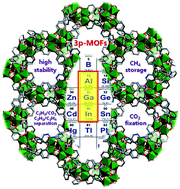A superstable 3p-block metal–organic framework platform towards prominent CO2 and C1/C2-hydrocarbon uptake and separation performance and strong Lewis acid catalysis for CO2 fixation†
Abstract
The design and synthesis of highly stable metal–organic framework (MOF) materials are urgently needed but are still challenging. Demonstrated herein is a superstable 3p-block metal–organic framework platform (3p-MOFs, SNNU-5-Al, Ga and In) inspired by the periodic law of elements. Apart from extra-high thermal stability (up to 500 °C), SNNU-5-Al shows excellent water tolerance (24 days at RT and 1 day at 80 °C in pure water) and prominent pH stability (4 to 12). Superlarge cuboctahedral and octahedral cages in SNNU-5s lead to excellent CO2 and C1/C2-hydrocarbon uptake and separation performance as well as excellent methane storage capacity under 65 bar pressure (345 cm3 g−1 at 273 K and 279 cm3 g−1 at 298 K for SNNU-5-Al). The strong Lewis acid nature of open 3p metal sites further makes SNNU-5 MOFs ideal heterogeneous catalysts for CO2 catalytic fixation with epoxides. Overall, this work provided a significant advance in the development of robust functional MOF materials for energy and environmental applications.



 Please wait while we load your content...
Please wait while we load your content...